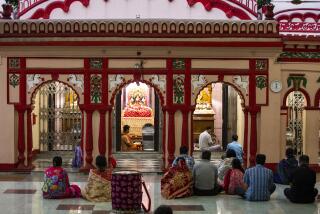Village Massacre Points to Wider Caste War in India
- Share via
NEW DELHI — Sixty-one bodies lying amid the huts of the village of Lakshmanpur in eastern India served warning Tuesday that the caste violence ravaging this country may be entering a new, more terrible phase.
The villagers, all from lower castes, were slain before dawn when a gang of 300 armed men descended on their hamlet and began firing into their huts. The killers shot and stabbed their victims for two hours; they left shouting Hindu slogans. Police said the gunmen appeared to be members of Ranbir Sena, a paramilitary group drawn from the region’s higher-caste landlords.
The incident, the worst caste-related massacre in recent years, was at the violent edge of a drastic transformation sweeping this country of 950 million people. India’s centuries-old societal hierarchy, sanctioned by religion and enforced by tradition, is under assault from the masses at its lower rungs. And the higher castes are striking back.
“What you are seeing is millions of people from the lower castes demanding dignity and respect for the first time and the higher castes refusing,” said C. P. Bhambhri, a political scientist at Jawaharlal Nehru University in New Delhi. “India is sitting on a social volcano.”
The massacre in Lakshmanpur was the latest in a string of caste-based killings. In July 1996, Ranbir Sena members gunned down 21 lower-caste villagers in the same state, Bihar. Last March, higher-caste gunmen shot and killed 10 lower-caste villagers in Haibaspur in Bihar. In September, 30 people who had been organizing lower-caste villagers in the state were gunned down by a rival group.
Caste has been the organizing principle of Indian society for more than 2,500 years, experts say, and only recently has the system begun to crack.
Under the Hindu religion, embraced by more than 80% of India’s population, each person has historically been born into an immutable social category, experts note. That category often dictates an individual’s occupation, status and world view. While there are four main castes--warriors, priests, traders and laborers--there are thousands of sub-castes, including those for rat-catchers and latrine-cleaners.
And more than 100 million Indians fall outside this system altogether: They are known as “untouchables,” and for centuries have been regarded as unworthy of charity or even minimal social contact.
While the Indian government formally outlawed the caste system almost five decades ago, it survives in varying forms throughout the country--particularly in villages, where more than 70% of the people live.
In some parts of India, untouchables do not drink from the same wells as the higher castes. They do not pray in the same temples or walk the same streets. Even the practice of dola, the right of a higher-caste man to violate the bride of an untouchable man on the couple’s wedding day, persists in some villages.
But in the past decade, lower castes have begun to enter politics and demand better treatment. The state assembly in Bihar, the second-most-populous state in India, is now dominated by lower-caste elected officials. Earlier this year, Kocheril Raman Narayanan became the country’s first untouchable president.
In the fields, lower castes have demanded higher wages and land ownership. Marxist groups--such as the Maoist Communist Center, the People’s War Group and the Naxalites--have gone into the villages and begun to organize the lower castes. Their message: Fight back.
Recent years have seen gangs of untouchables mounting attacks against higher-caste landlords in the states of Andhra Pradesh, Bihar, Tamil Nadu and Uttar Pradesh. In one incident five years ago, 200 armed untouchables entered a high-caste village in Bihar and cut the throats of 42 men.
“In some places, it is an undeclared civil war,” said Bhambhri, the political scientist.
The state of Bihar, one of India’s poorest and least developed, is the epicenter of caste violence. With more than 90 million people, it has virtually no heavy industry and a per capita income of about $70 a year. It has only one telephone for every 400 people. Only one man in three--and one woman in four--can read.
Experts say the poverty, exploding population and stagnant economy have combined to push the people to drastic action.
“There are so many people, and not enough to go around,” said Manisha Priyam, a professor of politics at the University of Delhi. “But when the lower castes try to assert themselves, the attitude of the landlords is: ‘How dare you question us?’ ”
On Tuesday, two boats carrying 300 gunmen sailed quietly across the Son River and onto the flat, fertile plain that holds the village of Lakshmanpur. Its 5,000 residents are almost all untouchables, though its sub-castes include the mallah, who sail boats; the chaudhary, who make moonshine from tree sap; and the chamar, who tan leather.
Witnesses said the gunmen killed the captains of their boats first, then set upon the villagers.
Lakshmi Bhagat, 65, walked in a daze among the bodies Tuesday. “My wife fell upon one of the attackers and told me to run,” Bhagat said. “She saved my life. They shot her in the head.”
Three families in Lakshmanpur had no survivors. The dead included four children under the age of 5. Members of the Communist Party of India/Marxist-Leninist got to Lakshmanpur before police did. It is one of many rebel groups seeking a radical redistribution of land, a proposal ardently opposed by upper-caste landlords.
With the two sides so bitterly at odds, police and experts say they expect the violence will go on.
“This is a different India,” said Bhambhri. “The untouchables are not going to go back to the old ways.”
Amitabh Sharma of The Times’ New Delhi Bureau and special correspondent Manish Kumar in Lakshmanpur contributed to this report.
More to Read
Sign up for Essential California
The most important California stories and recommendations in your inbox every morning.
You may occasionally receive promotional content from the Los Angeles Times.













